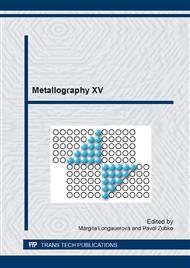p.191
p.197
p.201
p.205
p.209
p.215
p.221
p.227
p.231
The Effect of Long-Term Annealing at Elevated Temperature on Microstructure and Hardness of Heat-Resistant Steel
Abstract:
The stainless steel group AISI 310 is very often used for application in high-temperature conditions. This study investigated the effect of long-term annealing on microstructure and hardness of AISI 310S (24.3% Cr-19.3% Ni 1.8% Mn 0.21% Mo 0.67% Si, wt.%) heat-resistant steel. Microstructural changes and hardness distribution were analyzed after isothermal annealing at 800 °C in long-term exposure (from 1 to 1740 hours). Microstructure and fracture surface mode were analyzed using scanning electron microscopy (SEM) equipped with energy dispersive X-ray spectroscopy (EDS). It was found that after annealing the sigma phase particles were precipitated at grain boundaries and within austenite grains. The chromium content in the sigma phase increased with the prolongation of annealing time. The morphology of sigma phase was changed from fine precipitates at lower annealing times to coarser particles at higher annealing times. Also, presence of sigma phase was confirmed by transmission electron microscopy (TEM). At annealing temperature of 800 °C the hardness began to increase after 16 hours. With longer times of annealing the fracture surfaces were changed. This change is associated with a change of content and the morphology of sigma phase.
Info:
Periodical:
Pages:
209-214
Citation:
Online since:
April 2014
Authors:
Keywords:
Price:
Сopyright:
© 2014 Trans Tech Publications Ltd. All Rights Reserved
Share:
Citation:


